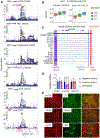Human genetics identify convergent signals in mitochondrial LACTB-mediated lipid metabolism in cardiovascular-kidney-metabolic syndrome
- PMID: 39561766
- PMCID: PMC11972450
- DOI: 10.1016/j.cmet.2024.10.007
Human genetics identify convergent signals in mitochondrial LACTB-mediated lipid metabolism in cardiovascular-kidney-metabolic syndrome
Abstract
The understanding of cardiovascular-kidney-metabolic syndrome remains difficult despite recently performed large scale genome-wide association studies. Here, we identified beta-lactamase (LACTB), a novel gene whose expression is targeted by genetic variations causing kidney dysfunction and hyperlipidemia. Mice with LACTB deletion developed impaired glucose tolerance, elevated lipid levels, and increased sensitivity to kidney disease, while mice with tubule-specific overexpression of LACTB were protected from kidney injury. We show that LACTB is a novel mitochondrial protease cleaving and activating phospholipase A2 group VI (PLA2G6), a kidney-metabolic risk gene itself. Genetic deletion of PLA2G6 in tubule-specific LACTB-overexpressing mice abolished the protective function of LACTB. Via mouse and human lipidomic studies, we show that LACTB and downstream PLA2G6 convert oxidized phosphatidylethanolamine to lyso-phosphatidylethanolamine and thereby regulate mitochondrial function and ferroptosis. In summary, we identify a novel gene and a core targetable pathway for kidney-metabolic disorders.
Keywords: GWAS; cardiovascular-kidney-metabolic syndrome; ferroptosis; genetics; kidney disease; mitochondria; phospholipase; phospholipid; serine protease.
Copyright © 2024 Elsevier Inc. All rights reserved.
Conflict of interest statement
Declaration of interests K. Susztak declares the following interests: research support from AstraZeneca, Bayer, Boehringer Ingelheim, Calico, Genentech, Gilead, GSK, Jnana, Lilly, Maze, Merck, Novartis, Novo Nordisk, Regeneron, Variant Bio, and Ventus; advisory board membership with Jnana Therapeutics and Pfizer; consultancy for AstraZeneca, Bayer, GSK, Jnana Therapeutics, Maze, Novo Nordisk, Pfizer, and Ventus; ownership of patents related to Jag1- and Notch-based targeting of chronic kidney disease; editorial board membership on Cell Metabolism, eBioMedicine, Journal of the American Society of Nephrology, Journal of Clinical Investigation, Kidney International, and Med. J.A.B. declares the following interests: research support from Pfizer, Elysium Health, and Metro International Biotech; consulting fees from Pfizer, Elysium Health, Cytokinetics, and Altimmune. D.J.R. declares the following interests: consultant/scientific advisory board for Alnylam, Novartis, and Verve. M.L.M. declares the following interests: shareholder and scientific adviser to Zenagem, LLC.
Figures






References
MeSH terms
Substances
Grants and funding
LinkOut - more resources
Full Text Sources
Medical
Molecular Biology Databases

